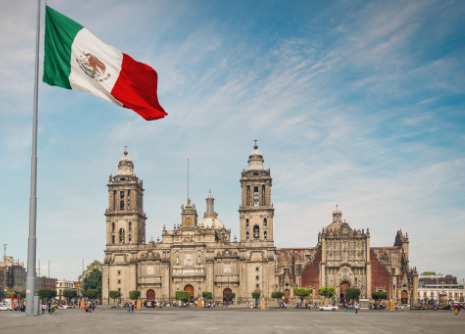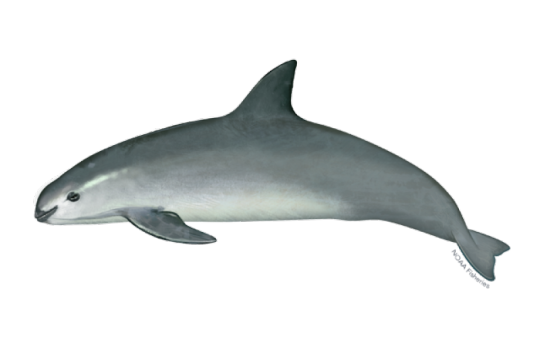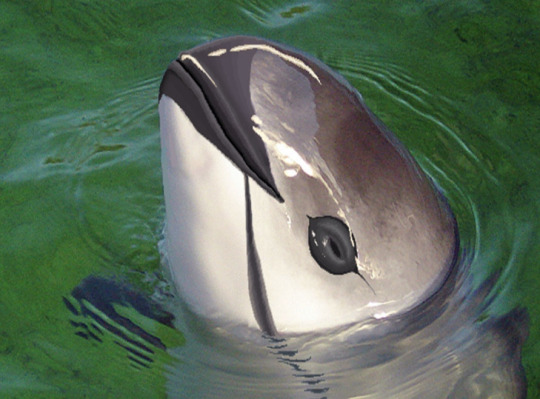#phocoena sinus
Text
Phocoena sinus - CITES Appendix I.

The Phocoena sinus is one of the 1,099 CITES Appendix I-listed animals and plants. Over 40,900 species are protected by CITES against overexploitation through international trade and are listed in the CITES three Appendices according to how threatened they are in international trade. CITES Appendix I (one) includes species that are the most endangered among all CITES-listed species and have the highest protection under CITES. For these species, international trade is only permitted when the purpose is not commercial, for instance for scientific research.
#cites#CITES Appendix I#most endangered#international trade#how threatened they are#endangered species#fish species#Phocoena sinus
0 notes
Text
Vaquita marina (Phocoena sinus) en pelígro crítico de extinción en Mexico
Esta es una lista con las especies en peligro crítico de extinción en Mexico
En este página hablaremos mas profundamente de Vaquita marina (Phocoena sinus)
Para ver mas información acerca el resto de especies, siga el enlace
Lobo mexicano (Canis lupus baileyi) – En peligro crítico.
Vaquita marina (Phocoena sinus) – En peligro crítico.
Tortuga laúd (Dermochelys coriacea) – En peligro…

View On WordPress
0 notes
Text
Critter fact #52:

The Vaquita (Phocoena sinus) is the most endangered animal on the planet. It is currently the smallest living cetacean, and is endendemic to the northern part of the Gulf of California.
1 note
·
View note
Text

International Save The Vaquita Day 2023 國際拯救加灣鼠海豚日
HEY HUMAN, SEE WHAT YOU DO!?
ANIMAN - FISHNET PHOCOENA
Instagram: milkdongcomics
Facebook: Milk DoNg Comics
#International Save The Vaquita Day#國際拯救加灣鼠海豚日#鼠海豚#Phocoena Sinus#極危#Critically Endangered#剩下約10條#Around 10 Only Left#漁網#Fish Net#非法捕魚#Illegal Fishing#石首魚#Totoaba Macdonaldi#花膠#Fish Tripe#ANIMAN#HEY HUMAN SEE WHAT YOU DO!?#Milk DoNg#Milk DoNg Comics#Art#Drawing#Sketching#Painting#Illustration#Character Design#Color Pencil
0 notes
Text
2050’ye Kadar Bir Çok Tür Yok Olacak
2050’ye Kadar Bir Çok Tür Yok Olacak
2050’ye Kadar Bir Çok Tür Yok Olacak
Dünya tarihinde 5 kitlesel yok oluş meydana geldi. Bilim insanlarına göre 6. kitlesel yok oluş çoktan başladı. Araştırmalar, şu anda yaşayan türlerin %40’ının 2050 yılına kadar yok olabileceğini ön görüyor.
27 yaşındaki orangutan anne, yeni doğan bebeğini tutuyor. 6 Ekim’de dünyaya gelen kız bebek, bu yıl Kuzey Amerika hayvanat bahçelerinde beklenen iki…

View On WordPress
#5 kitlesel#5 kitlesel yok oluş#6. kitlesel yok oluş#Amur leoparı#Bir Çok Tür Yok Olacak#Diceros bicornis#Dünya Doğayı Koruma Vakfı#Elephas maximus sumatranus#IPCC#IUCN#kara gergedan#kitlesel yok oluş#Kritik Tehlike Altında#Panthera pardus orientalis#Panthera tigris sondaica#Phocoena sinus#Pogo abelii#Sumatra fili#Sumatra orangutanı#Sunda kaplanı#Tehdit Aktındaki Türler Kırmızı Listesi#Uluslararası Doğayı Koruma Birliği#Uluslararası İklim Değişikliği Paneli#vaquita#WWF#yok oluş#yunus
0 notes
Text

Super excited to share my Vaquita piece for the new 2024 issue of Sea Unseen Zine (@seaunseenzine)! There are over 60 gorgeous marine-themed artworks in this issue, and all proceeds go towards the Australian Marine Conservation Society 🌊🐋🦈🦐
Keep reading below to learn a bit more about this small, critically endangered cetacean!
At just around 95 lbs in mass and 4.5 feet in length, the Vaquita (Phocoena sinus) is the world's smallest living cetacean! Like many other porpoises, they feed on a range small fish, squid, and crustaceans within their locality. They have an incredibly small range, known only to reside in shallow waters in upper Gulf of California. Due to their rarity, not much else is known about this species.
Sadly, the Vaquita is on the brink of extinction. Recent estimates suggest only 10 individuals remain. Illegal fishing operations result in these little cetaceans becoming bycatch, and is the biggest cause of their decline.
Current conservation efforts for the Vaquita seek to mitigate threats such as fisheries, pollution, and habitat destruction. Hopefully, with enough protection and patience, the population of this incredible animal will stabilize and even recover 💙
#seaunseenzine#vaquita#wildlife conservation#endangered species#marine life#charity zine#art zine#cetaceans
274 notes
·
View notes
Text


#endangered species#endangered#critically endangered#animal polls#polls#my polls#poll blog#tumblr polls#animals#vaquita#cetacean#cetacea#mammalia#marine mammals
62 notes
·
View notes
Text

Thank you very much to anon for your donation to Iyad's fundraiser! I hope you like this vaquita (Phocoena sinus)!
Fun fact: Vaquitas are the smallest species of porpoise, at only 150 cm (4.9 ft) long, and are the only species of porpoise found in warm waters.
Want to request your own art piece, or some uncharismatic facts? Just send me proof of donation to any of the fundraisers on this list, or a Palestinian organization of your choice! Proof does not have to include any personal info-- only the date, the amount, and the recipient.
11 notes
·
View notes
Text




Vaquita - Phocoena sinus endangered species
(not rlly fun facts)
Fun Fact 1 : from 2011 to 2016 alone, 90% of the vaquita population has dropped and now the estimated number for 2023 is 10-13 vaquitas (they live in Mexico). Before this in 1997 there was 600 vaquitas.(;_;)
Fun Fact 2 : A vaquita is a type of porpoise. Porpoises are one of the smallest members of the cetacean familv which includes dolohins and whales. Man species of porpoise are barely studied and most of what we know of them comes from when they are found washed up.
(´;Д;`)
Fun Fact 3 : The vaquita population has been declining because of illegal fishing with gillnets for an endangered fish called totoaba which is wanted for its swim bladder. When gillnets are used many species get caught in it by accident and get tangled while trying to escape, this happens to sea turtles a lot.。゚(゚´Д`゚)゚。
Post dedicated to the Vaquita (srry i didn’t realize i missed a day)
September 12 , 2023 ^ ^
#marine biology#fun facts#ocean life#ocean#marine science#salt water#scientific names#meow#endangered species#endangered animals#vaquita#dolphin#porpoise#sad facts
18 notes
·
View notes
Text

The group of mammals that includes whales, dolphins and porpoises is call Cetacea, and the subject of my recent oil painting is the world’s smallest Cetacean, the Vaquita (Phocoena sinus), little porpoise that, at maturity, is less than five feet long. The Vaquita is found only in the waters at the northern end of the Gulf of California and is critically endangered, down to about ten to twenty individual animals left, as of earlier this year. Its existence as a species was first established in 1958, based on the structure of skulls retrieved from dead individuals found on the beach, but it was only in 1985 that its external appearance was finally described. “Vaquita” means “little cow” in Spanish. No other marine mammal has such a small range.
The main threat to the species is another animal species found only in the Gulf of California, a large drum fish called the Totoaba (Totoaba macdonaldi), itself now an endangered species. I have shown a couple of them in the background. The problem is a demand by an Asian market for the swim bladders and meat of the Totoaba. The nets used to catch the fish caught, entangled drowned the Vaquitas. The bladders are a delicacy in Chinese cuisine, and the bladders are mistakenly credited with treating fertility, circulatory and skin problems. The demand for Totoaba commenced a century ago, after a native Chinese fish, the Chinese Bahaba (Bahaba taipingensis), also known as the Giant Yellow Croaker, as nearly exterminated. It is still critically endangered, with both fish species facing other threats captured by the catch-all rubric, environmental degradation.
A major threat to the north end of the Gulf of California’s marine life is all too well known: the salinity of this region, surrounded by land, has for thousands of years been determined by the flow of fresh water from the once mighty Colorado River, at the “top end” of the sea. But the water of that river, whose force carved the Grand Canyon upriver, and could fill the aquifer behind Hoover Dam, all gets drained off for farming, kitchen taps, golf courses, lawns, gardens, car washes and multiple other human uses before reaching the sea, while at the same time massively unprecedented draught grips the region.
Both Vaquita and Totoaba are protected, and work is underway to commercially raise the latter in fish farms, which potentially carry their own environmental risks. But there is not only poaching, but net captures of other marine life that still threaten both the Vaquita and the Totoaba. The latter has good survival potential but it is extremely frustrating to those of us who care that there seems really to be nothing that can be done to prevent the extinction of the Vaquita at some future point in the current century. It’s far from my best painting; I wanted to convey a sense of tranquility to symbolize the harmonization within nature even with its predatory and competitive nature whereas I perhaps should have tried a more stark or dramatic effect, perhaps the better to reflect my frustrations over my inability to reduce the damage we do to others, other species often unknown to most people, but I felt that at least I should paint its picture, chasing squid in the shallows, an imagined scene based on a reality soon to leave us.
The painting is in oils on compressed hardboard and is 24 by 30 inches in size.
77 notes
·
View notes
Text
In an effort to get myself used to this site and encourage me to use it more, I'm jumping on the Wet Beast Wednesday trend and posting facts about a different aquatic animal every week.
Starting off cute and sad, I’m going with the vaquita (Phocoena sinus). This dog-sized porpoise is the world’s smallest cetacean and it only lives in one place in the world: the northern end of the gulf of California near Baja. Sadly, they are critically endangered, with an estimated population of less than ten left in the world as of February 2022, making it the most endangered marine mammal (I couldn't find estimates for this year). This is primarily due to them getting tangled in gill nets from illegal fish poaching in their habitat. A study in 2022 indicated that the species may be able to repopulate but they would likely have genetic problems from a severe population bottleneck. Attempts to establish a captive breeding population were unsuccessful. Conservation efforts have generally been ineffective due to the sheer scale of illegal fishing activities, though there is cooperation between the USA and Mexico as well as international pressure on Mexico to crack down on the illegal fishing and protect the vaquitas

Not a lot is known about vaquitas due to how rare they are and because they were only identified as a species in the 50s through bones and scientists didn’t even see an intact specimen until 1985. What we do know is that they are very small, the the larger females reaching a maximum size of about 150 cm (4.9 ft). Males are believed to compete for mates and females usually reproduce once every two years. They are usually found alone or in small groups. Vaquitas have distinctive dark markings around the eyes and mouth.

The vaquita is on the edge of extinction and if rapid, extensive conservation efforts aren’t enacted, they will be gone forever. The vaquita could be a good symbol of why conservation is important and why conservation efforts need to be extensive and properly enforced for them to be effective. I could see them becoming a symbol for endangered species lie polar bears and pandas have become. They are in need of critical help but very well could survive with that help and they are adorable, which is always good for public awareness

#wet beast wednesday#marine biology#marine life#ecology#conservation#vaquita#biology#zoology#science#porpoises#cetaceans
33 notes
·
View notes
Text
Hello everyone! Damn, the paddlefish article has really brought a lot of new folks to this blog! Welcome everyone, and thank you so much for joining this lovely little project of mine--I am so grateful that so many people have taken an interest in my work and in the species I want to help protect.
Since there are so many new folks here, I wanted to give a brief rundown on the articles I've written so far. In the last year and a half of this project, I've been able to write about seventeen awesome and unique species that are in need of further conservation attention. Here are some links to learn more about them:
Olm (Proteus anguinus): the OG and mascot for the site, this eyeless salamander manages to survive in its pitch-dark cave biome through incredible sensory abilities and supernatural patience.
Indian Purple Frog (Nasikabatrachus sahyadrensis): this comically-ugly creature is also incredibly mysterious, spending its entire life underground and only emerging for a single day each year.
Pygmy Hippo (Choeropsis liberiensis): this secretive, pig-sized mammal is the only surviving relative of the mighty river hippo, but lives a completely different lifestyle from its much more famous cousin.
Scaly-Foot Snail (Chrysomallon squamiferum): one of the weirdest animals on the planet, this snail grows a shell reinforced with iron and lives around hydrothermal vents deep beneath the surface of the Indian ocean.
Kaua'i Cave Wolf Spider (Adelocosa anops): this blind cave spider is one of the rarest arthropods on Earth, and lives in tunnels carved by lava flows beneath the surface of the Hawaiian Island of Kaua'i.
Shoebill (Balaeniceps rex): this huge African water bird uses its tremendous beak like a guillotine to smash and decapitate its prey.
Largetooth Sawfish (Pristis pristis): this relative of sharks and rays has a tremendous nose lined with teeth which it uses to dig up and swipe at prey, but that's not the only thing its nose is good for.
Takin (Budorcas taxicolor): this large goat relative is quite possibly the most mysterious large land mammal on Earth, as it lives deep in the forested mountains of China, India, and Bhutan.
Zacatuche (Romerolagus diazi): also known as the "volcano rabbit", this adorable little fellow is an excellent gateway into understanding the benefits of grasslands to ecosystems and human settlements alike. Done in collaboration with Mexico'a CONANP.
(tambien en español)
Secretarybird (Sagittarius serpentarius): this badass raptor stalks the African savannah, using its powerful legs to deliver one of the fastest and most accurate kicks in the animal kingdom (and yes it's also the bird from Aggretsuko).
Manchineel (Hippomane mancinella): the first plant written about on Consider Nature (though certainly not the last), the manchineel is quite possibly the most toxic tree in the world, with every part of its anatomy steeped with a variety of noxious substances.
Gharial (Gavialis gangeticus): this crocodilian is a fish specialist, using its long, slender snout like a rapier to cut through the water and snag its prey.
Vaquita (Phocoena sinus): the most-endangered mammal on the face of the Earth, the Vaquita is a tiny porpoise that has gotten caught up in the black market trade of an extremely valuable fish bladder. Done in collaboration with Sea Shepherd International.
Pekapeka (Mystacina tuberculata): this tiny bat species is one of only 2 mammals native to New Zealand and spends more time on the ground than any other bat species in the world, despite being able to fly.
Angular Roughshark (Oxynotus centrina): this shark is native to the coasts of Western Europe and Africa, where it lives over a thousand feet beneath the waves and is rarely seen by people.
Marine Iguana (Amblyrhynchus cristatus): these iguanas are the only seafaring lizards in the world, and have developed a variety of remarkable adaptations to survive the extreme conditions of the Galapagos Islands.
And as always, if you have any suggestions, questions, or just want to say hi, you can DM me here or email me at [email protected]. Welcome, and thank you for your support.
4 notes
·
View notes
Text
The vaquita, also known as the Phocoena sinus, is a small porpoise that is native to the northern area of the Gulf of California. This divine sea creature can grow to be approximately five feet long and, when fully grown, weighs around 120 pounds. The animal has been on the endangered list for several years now, but concerns about its survival are growing. There were 600 vaquitas in 1997. The population dwindled to 30 in 2017, and today, there are thought to be only about 10 left.
3 notes
·
View notes
Text
TOP 10 of the rarest animals on Earth known to man:
#10. Vaquita
On the brink of extinction, the vaquita is the smallest living species of cetacean. ©Paula Olson, NOAA, Public domain, via Wikimedia Commons – License
The single rarest animal in the world is the vaquita (Phocoena sinus). This porpoise lives only in the extreme northwestern corner of the Gulf of California in Mexico. Since the population was recorded at 567 in 1997, it has since…

View On WordPress
2 notes
·
View notes
Text
Vaquita marina (Phocoena sinus)

La vaquita marina, también conocida como el panda del mar, es uno de los mamíferos marinos más raros y en peligro de extinción. Su pequeño tamaño y el distintivo patrón de manchas en su cuerpo la hacen inconfundible. Lamentablemente, la pesca ilegal y los esfuerzos de conservación insuficientes han llevado a esta criatura a un estado crítico.
0 notes
Text
Guacamaya roja (Ara macao) en pelígro crítico de extinción en Mexico
Esta es una lista con las especies en peligro crítico de extinción en Mexico
En este página hablaremos ms profundamente de Guacamaya roja (Ara macao)
Para ver mas información acerca el resto de especies, siga el enlace
Lobo mexicano (Canis lupus baileyi) – En peligro crítico.
Vaquita marina (Phocoena sinus) – En peligro crítico.
Tortuga laúd (Dermochelys coriacea) – En peligro…

View On WordPress
0 notes